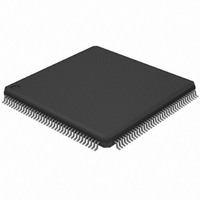AT32UC3A364-ALUT Atmel, AT32UC3A364-ALUT Datasheet - Page 46

AT32UC3A364-ALUT
Manufacturer Part Number
AT32UC3A364-ALUT
Description
IC MCU 64KB FLASH 144LQFP
Manufacturer
Atmel
Series
AVR®32 UC3r
Specifications of AT32UC3A364-ALUT
Core Processor
AVR
Core Size
32-Bit
Speed
66MHz
Connectivity
EBI/EMI, I²C, IrDA, MMC, SPI, SSC, UART/USART, USB OTG
Peripherals
Brown-out Detect/Reset, DMA, POR, WDT
Number Of I /o
110
Program Memory Size
64KB (64K x 8)
Program Memory Type
FLASH
Ram Size
128K x 8
Voltage - Supply (vcc/vdd)
1.65 V ~ 1.95 V
Data Converters
A/D 8x10b
Oscillator Type
Internal
Operating Temperature
-40°C ~ 85°C
Package / Case
144-LQFP
Processor Series
AT32UC3x
Core
AVR32
Data Bus Width
32 bit
Data Ram Size
96 KB
Interface Type
IrDA/SCI/SCIF/UDI
Maximum Clock Frequency
66 MHz
Number Of Timers
3
Operating Supply Voltage
3 V to 3.6 V
Maximum Operating Temperature
+ 85 C
Mounting Style
SMD/SMT
3rd Party Development Tools
EWAVR32, EWAVR32-BL, KSK-EVK1100-PL
Development Tools By Supplier
ATAVRDRAGON, ATSTK500, ATSTK600, ATAVRISP2, ATAVRONEKIT, ATEXTWIFI, ATEVK1104
Minimum Operating Temperature
- 40 C
Controller Family/series
AT32UC3A
No. Of I/o's
110
Ram Memory Size
64KB
Cpu Speed
66MHz
No. Of Timers
2
Rohs Compliant
Yes
For Use With
ATEVK1104 - KIT DEV/EVAL FOR AVR32 AT32UC3AATAVRONEKIT - KIT AVR/AVR32 DEBUGGER/PROGRMMRATEVK1100 - KIT DEV/EVAL FOR AVR32 AT32UC3A
Lead Free Status / RoHS Status
Lead free / RoHS Compliant
Eeprom Size
-
Lead Free Status / Rohs Status
Lead free / RoHS Compliant
Available stocks
Company
Part Number
Manufacturer
Quantity
Price
- Current page: 46 of 1014
- Download datasheet (16Mb)
7.5.5.2
7.5.5.3
7.5.6
7.5.6.1
7.5.6.2
32072C–AVR32–2010/03
Peripheral Clock Masking
Selecting synchronous clock division ratio
Clock ready flag
Cautionary note
Mask ready flag
The main clock feeds an 8-bit prescaler, which can be used to generate the synchronous clocks.
By default, the synchronous clocks run on the undivided main clock. The user can select a pres-
caler division for the CPU clock by writing CKSEL.CPUDIV to 1 and CPUSEL to the prescaling
value, resulting in a CPU clock frequency:
Similarly, the clock for the PBA, and PBB can be divided by writing their respective fields. To
ensure correct operation, frequencies must be selected so that f
must never exceed the specified maximum frequency for each clock domain.
CKSEL can be written without halting or disabling peripheral modules. Writing CKSEL allows a
new clock setting to be written to all synchronous clocks at the same time. It is possible to keep
one or more clocks unchanged by writing the same value a before to the xxxDIV and xxxSEL
fields. This way, it is possible to e.g. scale CPU and HSB speed according to the required perfor-
mance, while keeping the PBA and PBB frequency constant.
For modules connected to the HSB bus, the PB clock frequency must be set to the same fre-
quency than the CPU clock.
There is a slight delay from CKSEL is written and the new clock setting becomes effective. Dur-
ing this interval, the Clock Ready (CKRDY) flag in ISR will read as 0. If IER.CKRDY is written to
1, the Power Manager interrupt can be triggered when the new clock setting is effective. CKSEL
must not be re-written while CKRDY is 0, or the system may become unstable or hang.
By default, the clock for all modules are enabled, regardless of which modules are actually being
used. It is possible to disable the clock for a module in the CPU, HSB, PBA, or PBB clock
domain by writing the corresponding bit in the Clock Mask register (CPU/HSB/PBA/PBB) to 0.
When a module is not clocked, it will cease operation, and its registers cannot be read or written.
The module can be re-enabled later by writing the corresponding mask bit to 1.
A module may be connected to several clock domains, in which case it will have several mask
bits.
Table 7-7 on page 57
The OCD clock must never be switched off if the user wishes to debug the device with a JTAG
debugger.
Note that clocks should only be switched off if it is certain that the module will not be used.
Switching off the clock for the internal RAM will cause a problem if the stack is mapped there.
Switching off the clock to the Power Manager (PM), which contains the mask registers, or the
corresponding PBx bridge, will make it impossible to write the mask registers again. In this case,
they can only be re-enabled by a system reset.
Due to synchronization in the clock generator, there is a slight delay from a mask register is writ-
ten until the new mask setting goes into effect. When clearing mask bits, this delay can usually
contains the list of implemented maskable clocks.
f
CPU
=
f
main
⁄
2
(
CPUSEL
+
1
)
CPU
AT32UC3A3/A4
≥ f
PBA,B
. Also, frequencies
46
Related parts for AT32UC3A364-ALUT
Image
Part Number
Description
Manufacturer
Datasheet
Request
R

Part Number:
Description:
KIT DEV/EVAL FOR AT32UC3A3
Manufacturer:
Atmel
Datasheet:

Part Number:
Description:
DEV KIT FOR AVR/AVR32
Manufacturer:
Atmel
Datasheet:

Part Number:
Description:
INTERVAL AND WIPE/WASH WIPER CONTROL IC WITH DELAY
Manufacturer:
ATMEL Corporation
Datasheet:

Part Number:
Description:
Low-Voltage Voice-Switched IC for Hands-Free Operation
Manufacturer:
ATMEL Corporation
Datasheet:

Part Number:
Description:
MONOLITHIC INTEGRATED FEATUREPHONE CIRCUIT
Manufacturer:
ATMEL Corporation
Datasheet:

Part Number:
Description:
AM-FM Receiver IC U4255BM-M
Manufacturer:
ATMEL Corporation
Datasheet:

Part Number:
Description:
Monolithic Integrated Feature Phone Circuit
Manufacturer:
ATMEL Corporation
Datasheet:

Part Number:
Description:
Multistandard Video-IF and Quasi Parallel Sound Processing
Manufacturer:
ATMEL Corporation
Datasheet:

Part Number:
Description:
High-performance EE PLD
Manufacturer:
ATMEL Corporation
Datasheet:

Part Number:
Description:
8-bit Flash Microcontroller
Manufacturer:
ATMEL Corporation
Datasheet:

Part Number:
Description:
2-Wire Serial EEPROM
Manufacturer:
ATMEL Corporation
Datasheet:











